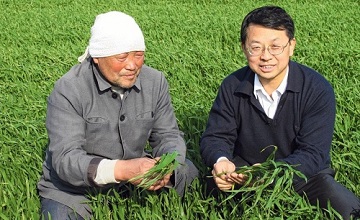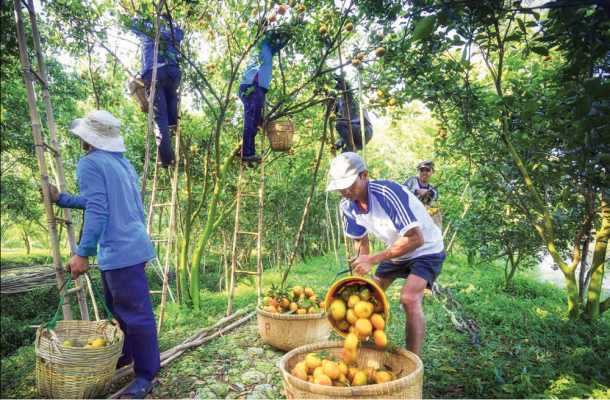President and CEO Richard Courey said Vision Transportation Group (VTG) was willing to take on the problem of transport and logistics infrastructure in the Mekong Delta.

Prime Minister Nguyen Xuan Phuc welcomed Mr. Richard Courey and other entrepreneurs interested in investing in Vietnam at “The Vegetables and Logistics Forum” in Dong Thap Province in December 2017
How do you assess the status of transport and logistics in the Mekong Delta?
Clearly there are a lot of logistical and traffic activities going on in the Mekong Delta, with river traffic being the natural backbone for this area. Therefore, the improvement of the logistics and waterway transport system is considered as the key for the development of the whole area. The Vietnamese Government has recognizes that importance, as evidenced by the fact that it is part of the master plan for regional development that sets out the above. Many transportation and logistics structures have been built in the past. New bridges and roads have sprouted everywhere and the irrigation system has been improved on a large scale. In my opinion, transportation, logistics and agriculture are just like relationships in a marriage, where the components are interrelated and mutually supportive. In the future, the government will need a lot more investments to further promote this “marriage”.

Modern metro system costs $ 3.3 billion by VTG in Dubai (UAE)
Vietnam’s agricultural prices have currently been pushed up partly due to the high cost of logistics. According to you, what goals should be focused on developing logistics and transport to enhance the competitiveness of Vietnamese agricultural products?
Traditionally, the infrastructure of transportation and logistics in the Mekong Delta is based on the grain economy. Like the traditional approach in countries such as Canada, the first step is to grow and harvest agricultural products in large quantities, followed by concentrating everything in one place before shipping to the consumption places, which means there is always a certain delay. In the present era, we need to add the concept of “timely delivery” if we want to move from traditional agricultural production to agricultural industrialization. Nowadays, we need to have the concept of “timely delivery” if we want to move from traditional agricultural production to agricultural industrialization.
The competitiveness of the agricultural sector depends on the efficiency of logistics and transportation. In developed countries, logistics accounts for 7-10% of GDP, but in the case of Vietnam, this figure is averagely more than 20%. It should be noted that prices of agricultural products are quite stable, so it is hard for Vietnamese farmers to raise prices to increase profits. Instead, the ratio of logistics and transport to GDP should be adjusted to achieve this, thereby encouraging them to shift to more sustainable agriculture. Thus, we need to have an integrated transportation system with agricultural production, ensuring that agricultural products are distributed in a timely and appropriate manner.
How to build the waterway transportation system on the tangled river network in the direction of optimally serving for delivering agricultural products and agriculture?
We need to plan the Mekong River current in the direction that we can allow many types of ships to pass through, from 7,000 to 10,000 tons. For each type of product, a suitable type of ship will be required, not only on the main rivers but also on the tributaries. VTG is a corporation specializing in providing transportation and logistics solutions. With a river network as such, we can decide a traffic and logistics system that is suitable for the products in the area.

Mr. Richard Courey and other foreign investors discuss about the general solutions for logistics in the Mekong Delta
In your opinion, what transportation and logistics system will be suitable with the present situation of the Mekong Delta?
We believe in the “Nine Dragons” plan that was presented at the workshop in December 2017 in Dong Thap. Accordingly, the major rivers of the region play the role of a backbone. We need to improve the canal system so that they can assume the pivotal role of river transport. Next, farmers should be able to bring their products to wholesale markets, develop and improve their processing and packaging capacities through the formation of cooperative forms in order to transform the grain economy into high value organic products. Secondly, one or two deep-water ports should be built at the central intersections in the Mekong Delta to enhance the competitiveness of the international transportation system. Finally, we complete the system by connecting roads, railways, and auxiliary tributaries. The ideal route to reduce costs is from farm to transshipment place, to large port and then to final destination. Another point is to diversify the capacity of Can Tho Airport, not only passengers but also freight transport, especially high quality items that require timely delivery.

Logistic nodes in VTG’s “Nine Dragons” plan
VTG has participated in many transportation and logistics projects in other countries, could you share some experiences in mobilizing capital in complex projects such as in the Mekong Delta?
Vietnam has the advantage of moderate weather. With the current orientation, the Vietnamese government is moving from a grain economy to an organized, industrialized and organic agriculture. Of course, the Government of Vietnam is facing a lot of financial constraints in developing appropriate infrastructure for that orientation. For the private sector, we are always willing to invest in infrastructure development in the form of public-private partnership (PPP).

The Confederation Bridge in Canada costs $ 1 billion
Fortunately, Vietnam has set up a legal basis for PPP, allowing us to work with the government (now we are doing it) to develop a strategy for developing a transport and logistics system effectively and feasibly. It should be noted that the most important thing of this effort is to bring practical benefits and a golden opportunity to Vietnamese people, especially farmers in the Mekong Delta.
Could you share the progress of the feasibility study in the area?
We have researched the possibilities of attracting investment based on the approved master plan. After discussions with stakeholders and, of course, with the permission of the Government of Vietnam, our priority is to improve the capacity of the waterway system in the Mekong Delta, such as how to connect Cat Lai Port and Can Tho Port with Can Tho Airport. Second is the construction of deep-water ports in the area, which is the key to attract more investment. We are also completing the final feasibility study, or what we call a detailed action plan. The method of conducting this plan does not only apply to the Mekong Delta Region, but also to other locations in Vietnam. We plan to release a detailed plan this year after thoroughly considering the elements of water management.

Dong Thap Provincial People’s Committee Chairman Nguyen Van Duong spoke with Mr. Richard Courey
We would like to share with you that we have a strategic agreement with Dong Thap Province to build a connection system with Cat Lai Port and other places, establishing a new road linking with Cao Lanh Bridge. It can not only serve agricultural activities but also contribute to the promotion of ecotourism, specifically at Tram Chim National Park. We are very excited to welcome the opening opportunity ahead.
Thank you Sir!
Source: Journal of Management (Mau Tuat 2018).

 Tiếng Việt
Tiếng Việt



